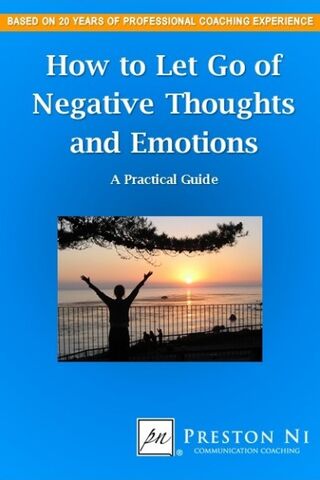Anxiety
10 Tips to Change From Reactive to Proactive in Situations
How to be less reactive in difficult situations.
Posted April 19, 2015 Reviewed by Jessica Schrader

All of us encounter experiences in life when we may be temporally overwhelmed by a negative emotion, be it anger, pressure, nervousness, despair, or confusion. In these situations, how we choose to “master the moment” can make the difference between proactive versus reactive, confident versus insecurity, and success versus failure.
Below are 10 ways to be less reactive in difficult situations, with excerpts from my book (click on title): “How to Let Go of Negative Thoughts and Emotions.” What all of these tips have in common is that they introduce a positive interruption to a negative mental or emotional state. These mindful interjections, however brief or long, provide a psychological opening from which you can recalibrate and choose more empowering action. Not all of these tips may apply to your particular situation. Simply use what works and discard the rest.
1. If you feel angry and upset with someone, before you say or do something you might later regret, take a deep breath and count slowly to ten. In most circumstances, by the time you reach ten, you would have figured out a better way of communicating the issue, so that you can reduce, instead of escalate the problem. If you're still upset after counting to ten, take a time out if possible, and revisit the issue after you calm down.
2. When you feel adversely about someone’s behavior towards you, avoid jumping to a negative conclusion right away. Instead, come up with multiple ways of viewing the situation before reacting. For example, I may be tempted to think my friend didn’t return my call because she’s ignoring me, or I can consider the possibility that she’s been very busy. When we avoid personalizing other people's behaviors, we can view their expressions more objectively, and reduce the possibility of misunderstanding (1).
3. If you’re dealing with a difficult individual, try to put yourself in the challenging person’s shoes, even for just a moment, and complete the sentence: “It must not be easy…” For example:
“My child is being so resistant. It must not be easy to deal with his school and social pressures…”
“My supervisor is really demanding. It must not be easy to have such high expectations placed on her performance by upper-management…”
To be sure, empathetic statements do not excuse unacceptable behavior. The point is to remind yourself that people do what they do because of their own issues. As long as we’re being reasonable and considerate, difficult behaviors from others say a lot more about them than they do about us.
For more tips on how to deal with difficult people, see my books How to Communicate Effectively and Handle Difficult People and How to Successfully Handle Passive-Aggressive People.
4. When someone’s pressuring you to make a decision you’re not sure about, simply buy time and say: “I’ll think about it.” This phrase can instantly lift the psychological pressure, and put you in greater control of the situation. Whether it’s an acquaintance asking for a favor, a romantic interest pursuing a date, or intense sales pressure, take the time you need to evaluate the pros and cons of the situation, and consider whether you want to negotiate a different arrangement, or if you’re better off by saying “no.”
5. If you feel nervous and anxious, put cold water on your face, which triggers the mammalian diving reflex and immediately slows the heart rate between 10 to 25 percent. It's also helpful to get fresh air and take deep breaths from the diaphragm. (2)(3).
6. When you feel under stress, have a hot cup of decaffeinated green tea. Research shows that green tea contains the amino acid theanine, which helps reduce stress. Holding the warm beverage cup in your hand can elevate your mood as well. Avoid caffeinated beverages which can stimulate your nervousness (4)(5).
7. If you feel fearful or discouraged, try intense aerobic exercises. Energize yourself. The way we use our body affects greatly how we feel. As the saying goes—motion dictates emotion. As you experience the vitality of your body, your confidence will also grow (6)(7).
8. When you find yourself obsessing in a way you know it’s not good for you, whether it’s oversensitivity, unnecessary anxiety, or unhealthy rumination, use a technique developed by psychologist Eric Maisel and say to yourself: “I’m not tripping over this!” Distract yourself with constructive activities to avoid being stuck. Ask for feedback from trusted peers and credible advisors to maintain objectivity (8).
9. If you feel overwhelmed, confused, or uninspired, go into nature and surround yourself in colors of green and blue, which have a calming effect (9)(10). Find a panoramic view and look out into the distance. Walk. Take deep breaths. Immerse yourself in nature’s splendor. Come back with a fresh perspective and new inspiration.
10. When you go through setbacks and failures, ask: “What is the lesson here?” “How can I learn from this experience?” “What is most important now?” and “If I think outside the box, what are some better answers?” The higher the quality of questions we ask, the better the quality of answers we will receive. Ask constructive questions based on learning and priorities, and we can gain the proper perspective to help us tackle the situation at hand.
“I am not discouraged, because every wrong attempt discarded is another step forward.”
―Thomas A. Edison
“Abraham Lincoln lost eight elections, failed twice in business, and suffered a nervous breakdown before he became the president of the United States.” ―Wall Street Journal

For more tips on how to reduce or eliminate negative attitudes and feelings, see my books (click on titles): "How to Let Go of Negative Thoughts and Emotions” and "Are You Highly Sensitive? How to Gain Immunity, Peace, and Self-Mastery!".
© 2015 by Preston C. Ni. All rights reserved worldwide. Copyright violation may subject the violator to legal prosecution.
References
(1) Adler, Ronald & Proctor II, Russell. Looking Out, Looking In (2011).
(2) Marazziti, Donatella, Angela Di Muro, and Paolo Castrogiovanni. Psychological stress and body temperature changes in humans. Physiology & Behavior (1992).
(3) Speck DF, Bruce DS. Effects of varying thermal and apneic conditions on the human diving reflex. Undersea Biomed Research (1978).
(4) 5. Yokogoshi H, Kobayashi M, Mochizuki M, Terashima T. Effect of theanine, r-glutamylethylamide, on brain monoamines and striatal dopamine release in conscious rats. Neurochem Research. (1998).
(5) Winston AP, Hardwick E, Jaberi N. Neuropsychiatric Effects of Caffeine. Advances in Psychiatric Treatment 11 (2013).
(6) Petruzzello, Steven J., Daniel M. Landers, and Walter Salazar. Exercise and anxiety reduction: Examination of temperature as an explanation for affective change. Journal of Sport & Exercise Psychology (1993).
(7) Amen, Daniel G. Change Your Brain, Change Your Life (1999).
(8) Maisel, Eric. Thirty Days to Better Mental Health (2015).
(9) Margaret P. Calkins. Using Color as a Therapeutic Tool (2010).
(10) Itten, J. The Art of Color: The Subjective Experience and Objective Rationale of Color (1997).




